

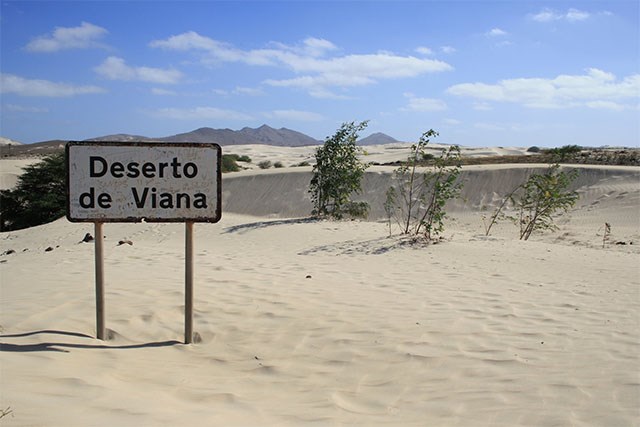

The Cape Verde islands, in particular the East Indies flat Sal, Boa Vista and Maio, are characterized by arid and semiarid conditions and incomplete, patchy vegetation in. Due to the special location within the main axis of the transport Saharan dust acts as the Sahara dust and sand supplier. Through the Wind Systems the Harmattan, the Saharan Air Layer, northeast trade winds
African Easterly Jet and is transported sand and dust in a westerly direction and deposited in Cape Verde.
The predominant in Cape Verde Wind conditions favor aeolian erosion and accumulation processes. In the aeolian erosion forms is between the small-scale, ground-level Korrasion and distinguish the planar deflation, the latter dominates in Cape Verde. The surface of different large grain sizes (eg from silt, sand and gravel), the selective effect of deflation have. The wind blows preferentially from fine material, coarse components remain. The result residuales desert pavement (also Hamada, Serir or Rikh called). After increased erosion of the first fine material the degree of deflation continues, as the coarse aggregate components even stronger cause turbulence.
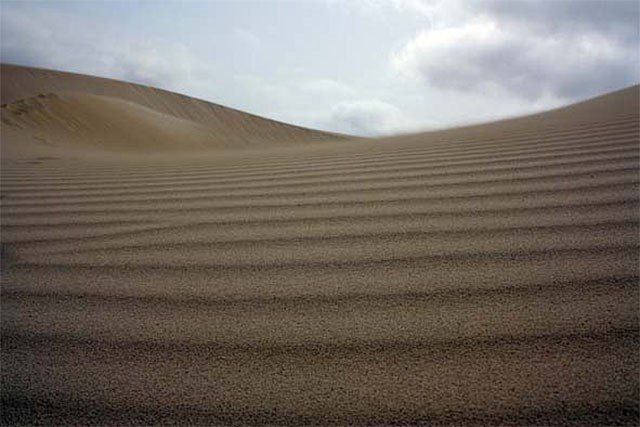
General Facts: Usually sands are the product of mechanical and chemical weathering of rocks. Therefore, first of all decide the bedrock on the composition of sand. When dark volcanic rocks weather (such as basalt), a "black" sand forms. Such a sandy one finds on beaches in Hawaii or the Canary Islands. Sets up a rock from different minerals together, such as granite, which consists mainly of feldspar, quartz and mica, these minerals are at least initially included in its decay products. If, however, the sand transported over long distances or is subject to an intense chemical weathering, softer and less chemically stable minerals such as mica and feldspars are gradually destroyed or dissolved. The final product is usually more or less a pure quartz sand. Naturally occurring sand is usually made from a blend of grains differed-varying size, which also shares of gravel, silt or clay are included. The exact composition of sand is determined in the laboratory by sieving the sand and the proportions of the various "grain fractions" (-> the breakdown follows the grain size distribution) based on the total weight of the sample can be determined. Flow deposits have here to have a wide range of grain sizes (from clay particles to large stones), on the other hand usually include flight Sande have only a narrow range. As diverse as the composition are also shades of natural sands. Desert sands of hot, dry climates usually have some brownish to reddish discoloration in various shades. Is caused by fine particles of natural iron compounds (mostly quartz) covering the larger grains. If wind, water or ice transported grains of sand, they are subject to mechanical abrasion. More rounded grains usually have therefore a longer trip behind the square grains of sand. But also different hardness of the mineral components plays a major role. Especially good rounded are beach sand, thrown up over a long time in the ocean surf.
Question 1: What is the "grain fraction" denotes the sandy spot on Sal, rather narrowly or more broadly?
Question 2: What is the material of occurring locally on Sal sand consists essentially?
Question 3: What is the form of locally occurring sand grains, they are more rounded or rather edgy? Why is this?
Send your answers to  . If the answeres are correctly, you will receive the log permission. Sign can you of course before, but without submitted answers I would delete your log later.
. If the answeres are correctly, you will receive the log permission. Sign can you of course before, but without submitted answers I would delete your log later.
Purely optional: About a picture of you all cachers will be happy:-)


Die Kapverdischen Inseln, insbesondere die flachen Ostinseln Sal, Boa Vista und Maio, sind durch aride und semiaride Bedingungen und eine unvollständige, lückenhafte Vegetation gekennzeichnet. Aufgrund der speziellen Lage innerhalb der Haupttransportachse des Saharastaubs fungiert die Sahara als Staub und Sandlieferant. Durch die Windsysteme des Harmattan, Saharan Air Layers, Nordostpassats und des African Easterly Jet wird Sand und Staub in westlicher Richtung transportiert und auf den Kapverden abgelagert.
Die auf den Kapverden vorherrschenden Windbedingungen begünstigen äolische Erosions- und Akkumulationsprozesse. Bei den äolischen Erosionsformen wird zwischen der kleinflächigen, bodennahen Korrasion und der flächenhaften Deflation unterschieden, wobei letztere auf den Kapverden dominiert. Besteht die Oberfläche aus verschieden großen Korngrößen (z.B. aus Schluff, Sand und Kies) kann die Deflation selektive Wirkung haben. Der Wind weht präferentiell Feinmaterial aus, grobe Komponenten bleiben zurück. So entsteht residuales Wüstenpflaster (auch Hamada, Serir oder Rikh genannt). Nach der Abtragung des ersten Feinmaterials erhöht sich der Grad der Deflation weiter, da die groben Gesteinskomponenten noch kräftigere Verwirbelungen verursachen.
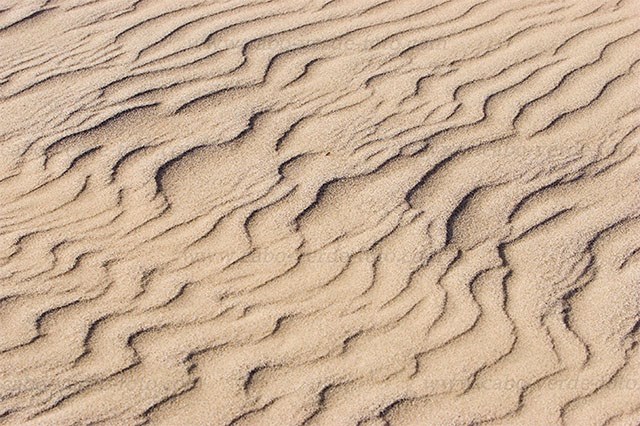
Allgemeine Fakten: In der Regel sind Sande das Produkt mechanischer und chemischer Verwitterung von Gesteinen. Von daher entscheidet zunächst einmal das Ausgangsgestein über die Zusammensetzung eines Sandes. Wenn dunkle vulkanische Gesteine (wie z.B. Basalt) verwittern, bildet sich ein entsprechender "schwarzer" Sand. Solch einen Sand findet man u.a. an Stränden auf Hawai oder den Kanarischen Inseln. Setzt sich ein Gestein aus verschiedenen Mineralen zusammen, beispielsweise ein Granit, der überwiegend aus Feldspat, Quarz und Glimmer besteht, sind diese Minerale zumindest anfangs auch in seinem Zerfallsprodukt enthalten. Wird der Sand jedoch über weite Strecken transportiert oder unterliegt er einer intensiven chemischen Verwitterung, werden weichere bzw. chemisch weniger stabile Minerale wie die Glimmer und die Feldspäte nach und nach zerstört oder aufgelöst. Das Endprodukt ist dann meistens ein mehr oder minder reiner Quarzsand. Natürlich vorkommender Sand besteht in der Regel aus einem Gemenge von Körnern unterschied-licher Größe, in dem auch Anteile von Kies, Schluff oder Ton enthalten sind. Die genaue Zusammensetzung eines Sandes wird im Labor bestimmt, indem der Sand gesiebt und die Anteile der verschiedenen „Kornfraktionen“ (-> die Aufteilung erfolgt nach der Korngrößenverteilung) bezogen auf das Gesamtgewicht der Probe ermittelt werden. Flussablagerungen haben i.d.R. hierbei ein breites Spektrum von Korngrößen aufzuweisen (von Tonpartikeln bis hin zu großen Steinen), Flugsande umfassen dagegen i.d.R. nur einen engen Bereich. Ebenso vielfältig wie die Zusammensetzung sind auch die Farbtönungen natürlicher Sande. Wüstensande aus heißen, trockenen Klimazonen etwa weisen meist bräunliche bis rötliche Verfärbungen in diversen Schattierungen auf. Ursache sind feine Partikel aus natürlichen Eisen-Verbindungen, die die größeren Körner (meist Quarz) bedecken. Wenn Sandkörner von Wind, Wasser oder Eis transportiert werden, unterliegen sie einem mechanischen Abrieb. Stärker abgerundete Körner haben daher meist eine längere Reise hinter sich als eckige Sandkörner. Allerdings spielt dabei auch die unterschiedliche Härte der Mineralkomponenten eine große Rolle. Besonders gut gerundet sind Strandsande, die über lange Zeit in der Meeresbrandung aufgewirbelt werden.
Frage 1: Welche „Kornfraktion“ kennzeichnet den Sand vor Ort auf Sal, eher eng oder eher breit?
Frage 2: Aus welchem Material besteht der vor Ort auf Sal vorkommende Sand im Wesentlichen?
Frage 3: Welche Form haben die vor Ort vorkommenden Sandkörner, sind sie eher abgerundet oder eher kantig? Warum ist dies so?
Sendet eure Antworten an  . Sofern alles richtig beantwortet ist, erhaltet ihr die Logfreigabe. Loggen könnt ihr selbstverständlich auch vorher, aber Logs ohne eingereichte Antworten werden später von mir gelöscht.
. Sofern alles richtig beantwortet ist, erhaltet ihr die Logfreigabe. Loggen könnt ihr selbstverständlich auch vorher, aber Logs ohne eingereichte Antworten werden später von mir gelöscht.
Rein optional: Über ein Foto von euch vor Ort würden sich alle Cacher freuen:-)
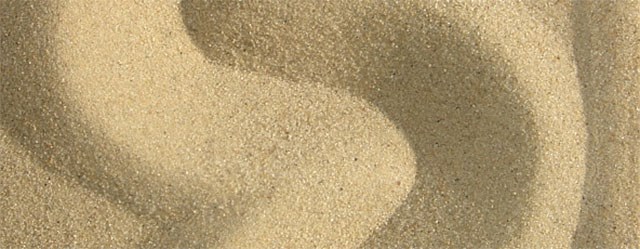

As ilhas de Cabo Verde, em particular o plano Sal Índias Orientais, Boa Vista e Maio, são caracterizadas por condições áridas e semi-áridas e incompleta, a vegetação desigual in. Devido à localização especial dentro do eixo principal dos transportes saarianos atos de poeira como a poeira do Saara e fornecedor de areia. Através dos Sistemas de vento o Harmattan, a camada de ar Subsaariana, ventos alísios de nordeste Africano Easterly Jet e é transportado areia e poeira, em direcção oeste e depositado em Cabo Verde.
A predominante em condições Cabo Verde vento favorecem os processos de erosão e de acumulação eólicos. Noformas erosão eólica é entre a pequena escala, ao nível do solo Korrasion e distinguir a deflação planar, este último domina em Cabo Verde. A superfície de diferentes tamanhos de grãos grandes (por exemplo, de lodo, areia e cascalho), o efeito seletivo de deflação tem. O vento sopra, preferencialmente, com material fino, componentes grosseiros permanecem. O resultado Residuales pavimento do deserto (também Hamada, Serir ou rikh chamado). Após o aumento da erosão do primeiro material fino o grau de deflação continua, como os componentes do agregado mineral ainda mais fortes causa de turbulência.
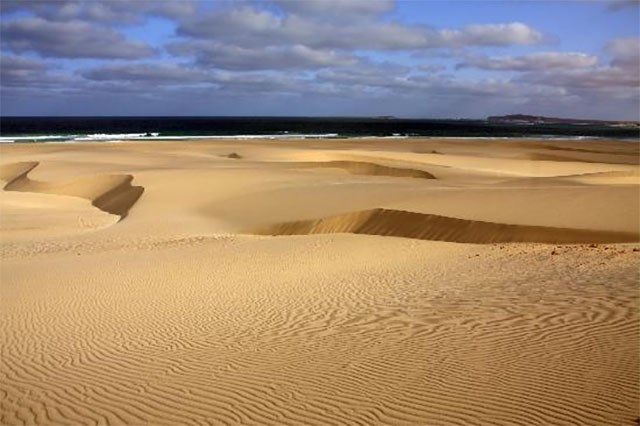
Fatos Gerais: Normalmente areias são o produto de intemperismo mecânica e química das rochas. Por isso, em primeiro lugar, decidir sobre a base da composição de areia. Quando as rochas escuras tempo vulcânica (como o basalto), forma-se uma areia "negros". Tal pessoa de areia encontra em praias do Havaí ou das Ilhas Canárias. Define-se uma pedra de diferentes minerais em conjunto, como o granito, que consiste principalmente de feldspato, quartzo e mica, estes minerais são pelo menos inicialmente incluído em seus produtos de decaimento. Se, no entanto, a areia transportados por longas distâncias ou está sujeito a um intenso intemperismo químico, minerais estáveis mais suaves e menos quimicamente como mica e feldspato são gradualmente destruídos ou dissolvido. O produto final é geralmente mais ou menos uma areia de quartzo puro. Naturalmente areia ocorrendo normalmente é feito de uma mistura de grãos de tamanho, o que também compartilha de cascalho, silte ou argila são incluídos variam de variação. A composição exacta de areia é determinado no laboratório por peneiração da areia e as proporções das várias fracções de grão "" (-> a repartição segue a distribuição de tamanho de grão) com base no peso total da amostra pode ser determinada. Depósitos de fluxo têm aqui a ter uma ampla gama de tamanhos de grão (a partir de partículas de argila de grandes pedras), por outro lado geralmente incluem voo Sande tem apenas uma faixa estreita. Tão diversas como a composição também são tons de areias naturais. Areias do deserto de climas quentes e secos geralmente têm algum marrom avermelhado descoloração em vários tons. É causada por partículas finas de compostos de ferro naturais (principalmente de quartzo), abrangendo os grãos maiores. Se o vento, água ou gelo transportado grãos de areia, eles estão sujeitos a abrasão mecânica. Grãos mais arredondados geralmente têm, portanto, uma viagem mais longa atrás dos grãos quadrados de areia. Mas também dureza diferente dos componentes minerais desempenha um papel importante. Especialmente bom arredondado são areia da praia, jogado para cima por um longo tempo na ressaca do oceano.
Pergunta 1: O que é a "fração de grãos" indica o local de areia na ilha do Sal, em vez restrito ou mais lato?
Pergunta 2: O que é o material de ocorrer localmente no Sal areia consiste essencialmente?
Pergunta 3: Qual é a forma de grãos de areia que ocorrem localmente, eles são mais arredondadas ou melhor nervoso? Por que isso?
Envie suas respostas para . Se os answeres são corretamente, você receberá a permissão de log. Signo pode você, é claro antes, mas sem respostas apresentadas gostaria de apagar o seu registo mais tarde.
. Se os answeres são corretamente, você receberá a permissão de log. Signo pode você, é claro antes, mas sem respostas apresentadas gostaria de apagar o seu registo mais tarde.
Puramente opcional: Sobre uma foto de você todos os cachers será feliz:-)
cumprimentos - dark sneaker
Various sources on the internet, e.g. http://de.wikipedia.org/wiki/Sand - Diverse Quellen im Internet, u.a. http://de.wikipedia.org/wiki/Sand - Várias fontes na internet, por exemplo http://de.wikipedia.org/wiki/Sand